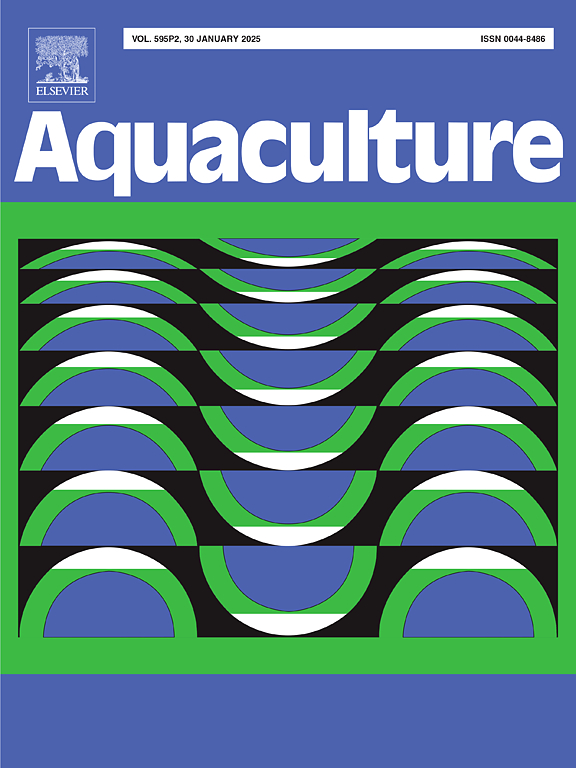Genetic parameters and genotype by environment interaction for harvest traits of Malabar red snapper (Lutjanus malabaricus)
IF 3.9
1区 农林科学
Q1 FISHERIES
引用次数: 0
Abstract
Malabar red snapper (Lutjanus malabaricus) is a tropical fish farmed in Singapore and Southeast Asia. Currently, eggs are produced in open net cages without controlled breeding, and no breeding program exists. The industry needs access to high-quality eggs from genetically improved stocks, highlighting the importance of developing a breeding program. However, fundamental genetic information, such as heritability and genetic correlations, is needed before implementing such a program. In this study, 2547 Malabar red snappers were genotyped using a custom Axiom 70k Red Snapper SNP array across three different rearing sites in Singapore. The body weight (BW), total length (TL), body depth (BD), Fulton's condition factor (K), body shape index (BSI) and skin redness (CIELAB *a values; Cla) of the fish were collected at harvest when fish were 18 months old. The mean ± standard deviation (SD) of all fish samples were 635.1 ± 222.7 g (BW), 327.0 ± 39.4 mm (TL), 115.2 ± 14.4 mm (BD), 1.76 ± 0.23 (K), 3.63 ± 0.24 (BSI) and 4.6 ± 2.9 (Cla). Heritabilities (h2), genetic correlations (rg) and genotype by environment interactions (GxE interaction) were estimated using BLUPF90 with an animal mixed model using the genomic relationship matrix (GRM). Heritabilities were observed to be moderate for BW (0.29 ± 0.03), TL (0.30 ± 0.03), BD (0.39 ± 0.05), K (0.21 ± 0.03) and BSI (0.21 ± 0.03), but low for Cla (0.04 ± 0.02). High genetic correlations were present among both growth (BW, TL and BD, rg ≥ 0.90) and body-shape traits (K and BSI, rg = 0.91), but lower for comparisons between growth (BW and BD) and body-shape traits (K and BSI) (0.21 ± 0.10 to 0.43 ± 0.09). These results indicate that both harvest growth traits and body shape of Malabar red snapper could be improved via selective breeding programs, although selection of fast growers might not maximize the genetic gain for K and BSI. In contrast, the low h2 of red colouration suggested that environmental factors (e.g. dietary carotenoids) rather than genetic effects may be primarily responsible for the phenotypic variation observed in skin redness. Moderate GxE interactions were observed for BW (0.45 ± 0.25 to 0.60 ± 0.27), TL (0.31 ± 0.24 to 0.57 ± 0.27), BD (0.40 ± 0.24), K (0.36 ± 0.25 to 0.73 ± 0.91) and BSI (0.73 ± 0.26) among the three rearing sites, suggesting that a single breeding program may not deliver equal genetic gains for all farms alike, and that genomic selection algorithms should be trained on the rearing site where animals are to be farmed. In conclusion, the present study provided valuable information for the design of future selective breeding programs for Malabar red snapper.
求助全文
约1分钟内获得全文
求助全文
来源期刊

Aquaculture
农林科学-海洋与淡水生物学
CiteScore
8.60
自引率
17.80%
发文量
1246
审稿时长
56 days
期刊介绍:
Aquaculture is an international journal for the exploration, improvement and management of all freshwater and marine food resources. It publishes novel and innovative research of world-wide interest on farming of aquatic organisms, which includes finfish, mollusks, crustaceans and aquatic plants for human consumption. Research on ornamentals is not a focus of the Journal. Aquaculture only publishes papers with a clear relevance to improving aquaculture practices or a potential application.
 求助内容:
求助内容: 应助结果提醒方式:
应助结果提醒方式:


